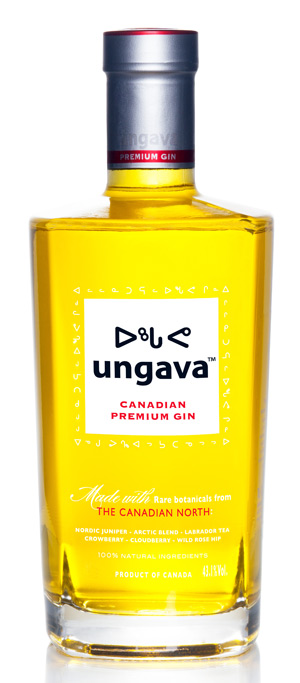
It is a difficult gin to miss. When Ungava won a Best of Show award at the prestigious World Spirits Competition, a judge noted its “unusual colour that helps grab your senses.” It’s perhaps the most polite way of drawing attention to Ungava’s yellow tint, about which producer Charles Crawford is slightly more blunt. “It’s a bit like morning’s vitamin-enriched urine,” he says. His PR people prefer “sunshine yellow.”
Ungava Gin is all about trying to paint the portrait of a place. Firstly, the Cree font near the word Ungava, tries to draw a parallel between many of the Cree nations which live in Northern Quebec. Secondly, Ungava makes use of a series of botanicals native to the northern Quebec region to create a connection with a place.
The place that Ungava is establishing ties to is Ungava Bay, a shallow bay with a cold climate not entirely conducive to plants and agriculture. Only a small bit of the southern piece of the bay is within the juniper’s range. Every year, Crawford hires “these two guys from Kuujjuaq” (he’s unsure of their names) to pick the botanicals during Ungava’s four-week harvesting season, which usually begins in late August. The pair pack “a couple hundred kilos” of their pickings into clear, pillowy bags and send them 1,500 km straight south to Ungava’s production facility in Cowansville, about an hour’s drive east of Montreal. A neutral spirit made with locally grown corn is infused with the botanicals.
Let’s take a look at them since most of them are quite unique to this gin.
Cloudberry: This tart berry grows in only very small quantities in its native range. Though hard to find, it has been used in many northern peoples’ food cultures. Many native northerners made spirits from them, but its most commonly found in jellies and jams. Also known as the “Bakeapple.”
Wild Rose Hips: It’s the fruit of the rose bush, and been used for jellies, teas and are very rich in vitamin C.
Arctic Blend: is a creeping evergreen used as a kind of tea by northern peoples.
Labrador Tea: is a flowering bog plant with white poofy flowers also used as a tea by the Inuit.
Crowberry: are another evergreen of the north, and these low lying plants produce round purplish berries that are used in jams and pies as well. A lot of tart/semi-sweet fruits in here.
